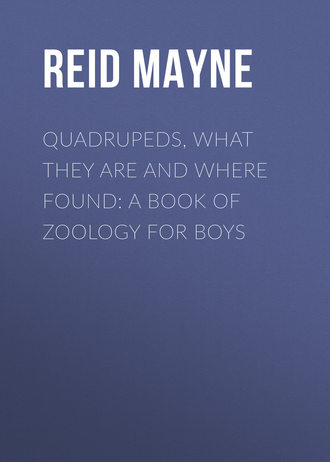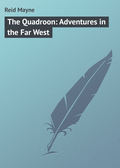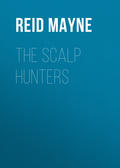
Майн Рид
Quadrupeds, What They Are and Where Found: A Book of Zoology for Boys
Chapter Fourteen.
The Hippopotamus, Rhinoceros, and Tapir
Though these three kinds of creatures belong to different genera, there is a certain family likeness among them that entitles them to be classed together; and since there are not many species of each, they will conveniently form a group.
Of late the hippopotamus has been the most notorious of the three; though he is far from being as interesting an animal as the rhinoceros. Since, however, he is at present the most popular, we shall give him the foremost place in our sketch.
The Hippopotamus was known to the Greeks and Romans. His name is Greek, and, as every one knows, signifies the River-horse. Why so called? you may ask – since between this unwieldy creature and the beautiful horse there does not appear a single point of resemblance. The answer is, that the cry of the hippopotamus was fancied to resemble the neighing of a horse; and in some respects this is really the case. Hence the misnomer. The Dutch of the Cape Colony call the creature a Cow, or Sea-cow, which is also an ill-adapted name. The cow is well enough, for the head and mouth of the animal bear a very striking resemblance to those of a broad-muffled cow; but what the “sea” has to do with it is not so clearly understood: since the hippopotamus is found only in fresh water in lakes and rivers.
Every one knows that this huge creature is of amphibious habits; and lives equally well on land, in the water, or even under the water. It requires air, however, and at intervals rises to the surface to breathe. On such occasions it usually projects a jet of water from its nostrils – in other words, it spouts, after the manner of the whales.
It is altogether herbivorous; and grass and the leaves of succulent plants form its subsistence. A vast quantity of these are required to sustain it; and a single individual will consume as much as two hundred pounds’ weight in a day.
The hippopotamus, notwithstanding its formidable appearance, is not a dangerous enemy if suffered to go unmolested, or rather if persons do not come in its way. When wounded, however, or even intruded upon in its solitary haunts, it will attack man himself; and a boat or canoe passing along a river frequented by these creatures is in danger of suffering a similar fate to that resulting from an encounter with the great whale – that is, of being tossed out of the water or broken to pieces.
The River-horse, or Sea-cow (whichever you prefer to call the creature), is exclusively confined to the African continent; and is found in all the great lakes and rivers from the Cape Colony to the southern limits of the Sahara. It is indigenous to the Upper Nile; but does not show itself in the lower half of that river. In fact, its range appears to be exactly co-terminal with that of the African elephant.
There is a question about the number of species. For long it was supposed there was only one, but now it is ascertained that two, or even more, exist. The hippopotami of the Nile differ considerably from each other and also from the species known as Sea-cow in South Africa; while a smaller kind than either has been observed in the rivers of Western Africa.
The Rhinoceros is altogether a more curious and interesting animal than the hippopotamus; but, being more common, and oftener encountered by modern travellers, it is at present less an object of curiosity.
Of rhinoceroses at least seven distinct species are known – three of them being Asiatic, and four African.
The largest of all is the Indian rhinoceros, which inhabits a part of Bengal and the countries beyond – Burmah, Siam, and Cochin China. This species is easily distinguished from the others by the thick rough skin, which is placed on the animal’s body in such a fashion as to resemble a coat of ancient armour. The singular protuberances have a complete resemblance to the “bosses” which were worn on the shields and breast-plates of warriors of the olden time.
A second species, the Warak, which inhabits Java, is somewhat similarly accoutred; but the third Asiatic kind, the Sumatran rhinoceros, has a smoother skin, more resembling that of the African rhinoceros.
These last-mentioned are denizens of the African continent; but especially of the regions extending northward from the Cape. They do not all four frequent the same district; but two, and sometimes three of them, are found in one locality. They are distinguished as the black and white rhinoceroses – there being two species of the black, and two of the white. The black ones are much fiercer than their white congeners; although the latter are by far the largest, and present a far more formidable appearance, from the extreme length of their horns.
The Tapir was for a long time supposed to be exclusively an American animal, but later research proves that there is also a species in Asia. It is found in the Island of Sumatra, and is larger than the American species, though very much resembling it in other respects. A new species has also been discovered in South America, altogether differing from the American tapir already so well-known.
The habits of the American tapir are not unlike those of the rhinoceros. It is a creature of great strength, and heavy in its movements. It can live for a long time under water; and its haunts are the banks of the great rivers – especially where these are marshy, and covered with reeds and other aquatic plants, which constitute its food. It can swim or walk under the water at will; but its lair is generally in some bushy retreat at a distance from the banks; and its visits to the water are usually nocturnal. It is an object of chase among the native Indians, who prize both its flesh and skin; but its capture is by no means an easy matter, since its thick hide renders it impervious to the tiny arrow of the blow-gun.
This species is found in all the rivers of South America, from Paraguay to the Isthmus of Darien; but its range terminates very abruptly on the north – a fact which puzzles the naturalist, since for many degrees further northward, climate and other circumstances are found similar to those which appear to favour its existence in the southern part of the continent.
The other species of American tapir differs considerably in the nature of its haunts and habits. In these it is said more to resemble the tapir of Sumatra. The latter is found dwelling at a great elevation, in fact, on the tops of the highest mountains of that island; whereas the Danta, or American tapir, is altogether confined to the low hot plains. In the same district of country, and even in the same rivers – but further up among the mountains – the smaller species of American tapir is met with, but never upon the low level of the plains.
When we consider that for more than three centuries, in a country inhabited by a civilised people, this new species of American tapir has remained not only undescribed but even unknown to the scientific world, we may fairly conjecture that other species of this, as well as of many other animals, may yet be brought to light to gratify the lover of nature, and add to his store of pleasant knowledge.
Chapter Fifteen.
Giraffes, Camels, and Llamas
Strictly speaking, the Giraffes cannot be considered as belonging to the same family with the Camels, nor yet the Camels be classed with the Llamas; but there is a very great resemblance between these three genera of animals, and, except for scientific purposes, they form a group sufficiently natural. Indeed any one of the three is more like to the other two than to any other kind of mammalia; although some naturalists prefer considering the giraffe as a species of deer. This classification, however, rests principally upon an erroneous supposition – that the oblong protuberances on the head of the giraffe are horns, which in reality they are not, but mere continuations of the frontal bone. It would be as absurd, therefore, to call the giraffe a deer, as to consider it a species of camel, and perhaps more so. It may be regarded as an animal sui generis; but in making a series of groups – such as we have here attempted – it appears more natural to place it alongside the camels than elsewhere; and it is certainly as much like the true camel or dromedary as either the llama or vicuña. One of its most popular names – that of Camelopard, or Spotted Camel – shows the resemblance which suggests itself to the eye of the traveller and ordinary observer; and this resemblance extends also to many characters that are not external. Indeed, after all that has been said by anatomical naturalists, we might hazard assertion of the belief, that the camelopard is neither more nor less than a species of wild camel.
Its appearance need not be described. Every eye is familiar with the slender form, long neck, smooth coat, and spotted skin of this singular animal. But its habits are less understood, and this arises from several distinct causes. In the first place, the giraffe inhabits only those countries about which very little is known by civilised people; secondly, it is but rarely seen, even by travellers; and, thirdly, when it is encountered in its native haunts, it is of so shy a disposition, and so ready to take flight, that scarce any opportunity is ever obtained for properly observing it.
The giraffe is exclusively confined to the continent of Africa; but its range is by no means limited. It was formerly common enough as far south as the Cape itself, whence it was driven by the Dutch and Hottentot hunters. It is not now met with to the south of the Great Orange River. Northward from this point, it extends to Nubia and Abyssinia; but it does not appear that it inhabits the western section of the continent, since it is not heard of in Guinea, or any of the countries on the Atlantic coast. In the interior it is common enough.
The giraffes herd together in small troops – consisting of ten or a dozen individuals – and prefer the open forests, or rather the hills covered with copses of acacia and other African trees. Their principal food is the foliage of these trees; and one species of mimosa – the camel-doorn (camel-thorn) of the Dutch hunters – is their especial favourite. The leaves of this tree, like all others of the acacia tribe, are of pinnate form, and sweet to the taste; and the giraffe browses upon them, standing erect, with its long neck outstretched to a height of nearly twenty feet! Its tongue is possessed of a peculiarly prehensile power, and with this extended a foot or more beyond the lips, it can sweep in the leaves and twigs for a wide circle around its muzzle.
When affrighted and put to its speed, the giraffe appears to go with an up-and-down gait, and some travellers have alleged that it limps. This arises from the fact, that every time it lifts its fore-feet, it throws back its long neck, which on other occasions is always held erect. It sometimes travels with a pacing step, but it can also gallop after the manner of a horse, and is even so swift that it requires a horse at full speed to overtake it.
Notwithstanding that its food consists principally of the leaves and twigs of trees, the giraffe will also eat grass. While browsing thus, it usually bends one of its knees downward; and while stretching upwards to a high branch, it brings all its feet nearer to each other. It often lies down to “chew its cud” or to sleep; and this habit produces the callosities upon the sternum and knees, which resemble those of the camels.
The giraffe is a peaceful and timid animal, and is often the prey of the lion – the fierce beast of prey taking it unawares, springing upon its back, and destroying it by breaking the cervical vertebrae with his powerful teeth. Sometimes, however, it is enabled to drive the lion off by kicking out against him with its heels, and tiring or discouraging him from the attack.
The Hottentots and Kaffirs hunt the giraffe for the sake of its flesh, which in young individuals is very good eating. Sometimes, however, it smells strongly of a species of shrub upon which the animal feeds, and which gives it a disagreeable odour. The Bushmen are particularly fond of the marrow produced in its long shank bones, and to obtain this, they hunt the animal with their poisoned arrows. They also make out of its skin bottles and other vessels for containing water.
Conspicuous as is the giraffe, it is not so easy to distinguish it in the haunts where it inhabits. Seen from a distance, it has the appearance of a decayed tree, and, remaining motionless, it is often passed by the hunter or traveller without being observed. It is itself very keen-sighted; and the manner in which its large beautiful eye is set gives it a decided advantage for seeing around it, even without the necessity of turning its head. On this account it is approached with great difficulty, and usually contrives to escape from the most ardent pursuer.
The Camels come next in turn. Of these there exist two distinct species – the Camel, or Bactrian camel; and the Dromedary, or Arabian camel. Both are found only in a domesticated state. Both are “beasts of burthen,” and of both there are several varieties.
First, then, of the Bactrian camel – that is, the species with two humps.
This animal differs very much from the Arabian camel, and is altogether more rare. It is about ten feet in length of body, and covered generally with a thick shaggy coat of hair of a dark brown colour; but there is no difficulty in distinguishing it from its Arabian congener. The two huge humps or hunches upon its back form a sufficient token by which to identify the species.
It is found in Persia and the adjoining countries; but in no part in such numbers as in the middle zone of Asia – in the Taurus, and to the north of the Himalaya Mountains. It is also seen occasionally in Arabia and other countries; but in these it is rare, the dromedary taking its place for all purposes required by man. It is, nevertheless, of a stouter build than the latter, and stronger in proportion to its size. As already stated, there are several varieties, produced by a difference in stature, colour, and swiftness.
The Dromedary, or Arabian camel, is altogether more widely distributed, and better known to the world. It is propagated in Arabia, Persia, the south of Tartary, some parts of India, in Africa from Egypt to Morocco, and from the Mediterranean Sea to the river Senegal. It is also numerous in the Canary Islands, and has been introduced into Italy, especially at Pisa, in Tuscany. It is not generally known that it has also been transported into the Island of Cuba, and employed at the mines of El Cobre, near Santiago; and later still – in fact, at the present hour – an attempt is being made to naturalise it upon the central plains of Texas and California.
The callosities upon the limbs and chest, and the hump on the back, have caused much perplexity among naturalists; but, perhaps, their purpose may be explained. They seem to bear some relation to the necessities of the animal, considered as the slave or man. The callosities are the points on which it kneels down to receive its burden. The hump, which is a fatty secretion, is known to be absorbed into the system when the animal is pinched for food, thus forming a provision against the casualties to which it is subject in a life evidently ordained to be passed in the desert. Add to this, that its singularly formed stomach renders it capable of containing a supply of water suitable to long journeys, and we have ample evidence of the purpose for which this singular and useful creature was designed.
The camel furnishes the Arab with flesh and milk, of its hair he weaves clothing, and even tents; his belt and sandals are the produce of its hide, and its dung affords him fuel.
The hair of the Persian camel is held in the highest estimation. There are three kinds of it – black, red, and grey; the black being of most value, and the grey fetching only half the price of the red.
But all such uses are mere trifles when compared with the value of these animals as beasts of burden – “ships of the desert,” as they have been poetically named. By means of them, communication is kept up between distant countries separated by large tracts of frightful deserts, which, without some such aid, would be entirely impassable by man.
We arrive at the Llamas, or camel sheep, as the old Spanish colonists used to call them.
These animals are natives of South America, and their range is limited. They are found only on the high plateaus of the Andes; through which they extend, from New Granada on the north to Chili on the south, though one species ranges even to the Straits of Magellan. In all there are four distinct species of them – the Llama proper, the Paca or Alpaca, the Guanaco, and the Vicuña.
The Llama and Paca are both held in a state of domestication; the former as a beast of burden, and the latter for its hair or wool. On the other hand, the Guanacos and Vicuñas are wild animals, and are eagerly hunted by the mountain tribes of Indians for their flesh and skins, but in the case of the vicuña for the very fine wool which it yields, and which commands an enormous price in the markets of Peru.
The Cordilleras of the Andes, below the line of perpetual snow, is the region inhabited by these creatures. In the hot countries, lying lower, they do not thrive; and even die in journeys made to the tropic coast lands. The wild species keep together in herds – sometimes of one or two hundred individuals – feeding on a sort of rushy grass or reed – called yea by the natives – and they scarce ever drink, so long as they can pasture on green herbage. They have the singular habit of going to a particular spot to drop their dung, which resembles that of goats or sheep; and this habit often costs them their lives, since the excrement points out to the hunter their place of resort. They keep a careful look-out against any danger, usually taking care to place old males as sentinels of the flock, who give warning of the approach of an enemy. When startled they run swiftly, but soon halt, stand gazing back, and then gallop on as before.
During summer they frequent the sides of the mountains; but, as winter approaches, they descend to the high table plains, and browse upon the natural meadows found there. They are captured in various ways. The Indians take them by first surrounding the herd, and then driving it within enclosures constructed for the purpose. They are also run down by dogs, trained to hunt them by the mountaineers of Chili, in which country they are found wild in great numbers. During the chase they frequently turn upon their pursuer, utter a wild shrill neighing, and then resume their rapid flight.
The Vicuñas – which are the smallest of the four kinds, and also the prettiest – are captured by the Indians in a still more singular manner. A large tract of the plains is enclosed merely by a cord, stretched horizontally upon stakes, of about four feet in height. To the cord are attached pieces of cloth, feathers, or coloured rags of any kind. Into this feeble enclosure the herd of vicuñas is driven; and, strange to say, the frightened animals will permit themselves to be crowded together, and killed with stones rather than leap over the cord.
When any guanacos chance to be mixed up with the herd, the result is likely to be very different. These, being of bolder spirit, as well as larger size, at once overleap or break through the fictitious barrier, and sweep off to the mountains, followed by the whole flock of the vicuñas.
The capability of the llama to carry burdens is well-known. They were thus employed by the ancient Peruvians, and, although at present they are less valued on this account, many are still used in carrying the ores from the rich gold and silver mines of Chili and Peru to the smelting furnaces, or ports of embarkation on the coast. The introduction of the mule, however, has to a great extent relieved the llamas of their load; and less attention is now paid either to their training or increase.







